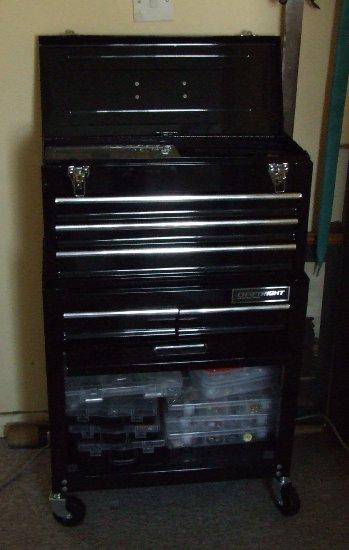-
Posts
5,928 -
Joined
Content Type
Profiles
Forums
Events
Blogs
Gallery
Everything posted by fredk
-
The clamps on the French both bow outwards before turning in to make the jaws. like this ( ) On the English one clamp is a straight extension of the leg then turns for the jaw. The other clamp bows out then turns in for the jaw. like this I )
-
For what I know, use black. Original pouches, holsters etc I've seen for the CS are black leather
-
Very many congratulations from me as well. If yours is 2nd place then the winner must be a real stunner and the competition must have been fierce To everyone on here you'll always be the winner, Ryan
-

Permanant sales shop (do you have your buisness locally?)
fredk replied to Ragingstallion's topic in Leatherwork Conversation
To cover some of the above. A true story event from a few years back. A customer goes into a Home Bakery and asks for an iced fruit cake to be made. The bakery refuses. Customer goes to a government body called Equal Rights Commission who takes up his case and takes said bakery to court. Bakery looses case. Bakery takes appeals through several courts until they win. Cost to small bakery, in excess of £70,000, cost to 'customer' is a big fat 0. Home Bakery, has a shop front and bakes all their goods on the premises. They also supply other bakery shops. They make only bread, just bread, loaves, fruit loaves, plain loaves, bread baps (burger buns to you lot), they do not make buns or cakes. That is why they refused to make the 'customer' a cake. They told the 'customer' this, they told the ERC, they told the court this but still they lost on 'discrimination' . The matter was pushed not on what the bakery makes or did not make, but on their refusal to supply someone based on the 'customer' being of one of the groups I mentioned, even though the refusal was not. There was a second cake case recently which cost a bakery £185,000 in costs and the 'customer' 0. Although its been revealed that the ERC lost about £280,000 in costs - so far, as they re taking the case to the European Courts. But this stage won't involve the bakery. In this case the bakery is a well known and liked family bakery and friends raised donations to pay their costs. The amount raised was £195,000. Without this the bakery owners would not only have had to close their two shops, making about 20 workers unemployed but they would have had to sell their home. This cake case is far more complicated but involves the same principles. -
I did not make an exception as I don't know how to. I cleared my cache and cookies and I got straight in without that blocking message that I got at first a few days ago. edited to add. My laptop has been shut down and restarted several times over the last lot of days, and the browser shut down even more times, and every time I restart and relaunch the browser I get straight in to this forum
-
I have straight-in access. No problems. The site is marked as 'Not Secure' in the address bar though Might I suggest that you all clear your cache then try access again
-
I know nowt about programming but I do remember when the local community newspaper I worked for got its first computer. It had a 6 inch screen. Everything we typed in was white on a black screen. Then we had to type in a load of commands to make it print out. One mistake and you had to type all those commands in again. Stupid thing was the bosses said everything had to be typed in and printed out, proof read, then sent to the printers who typed it into their printing computer. Up to then we just wrote it all on paper and sent it over. A lot of kerfuffle wasting time so it was.
-
No, no, no, no, no, no, no, no, no, no, no, Yes I prefer a double cheese
-
yeah but, no but, yeah but, no but, . . . . . . . if your computer mouse was a real mouse every time you scroll you'd be stroking its butt!
-
If the ram extends above the head you could try putting the magnets on the top end of it. You'll need more magnets for the magnetism to be effective. I did that on something (a mini-drill stand) as a temporary measure and it worked out ok.
-
me too. my browser was telling me that the site was under attack from hacking. I PM'd Joanna about it but I've not heard back yet
-
yes, versions are commonly available. some with two cutting blades. its a hole or disc cutter, for metal or wood. eg; https://www.ebay.co.uk/itm/ADJUSTABLE-CIRCLE-HOLE-CUTTING-DRILL-SAW-CHROME-/183252805928?hash=item2aaab7e928
-
When I require 'sheep skin fleece' I use the artificial species. I get it by the 1/4, 1/2 or full 1 yard from a fabric outlet. Costs about £4 for a 1/2 yard which yields lots and lots of pads
-

Tooled Iphone cover
fredk replied to YinTx's topic in Purses, Wallets, Belts and Miscellaneous Pocket Items
Questions: I presume the leather is quite thin, approx what thickness? and how did you prevent it from going out of shape whilst tooling it? -
The situation is echoed here. There is Ireland, Ireland, Northern Ireland, Ulster, Eire, Hibernia, Erin, United Kingdom and Great Britain I'll not hijack this thread with details, unless I'm asked to
-
Simplest way; get a ruler in your preferred measure, eg mm or inch. Start on the '0' line and wrap thread around the ruler, each turn tight up against the last. Keep going for a few inches or centimetres. Count how many threads there are an divide into the measure eg, if you have 80 turns over 2cm /20mm = each thread is 0.25mm
-
The Tandy press will do them with a set of dies; https://www.tandyleather.eu/en/product/press-dies-for-hand-press
-

Tooled Iphone cover
fredk replied to YinTx's topic in Purses, Wallets, Belts and Miscellaneous Pocket Items
That shore is purty -
The top part of the unit is separate. It can be bought in 2, 3, 4 5 & 6 drawer sizes. The 6 is 4 uneven shallow drawers and two large ones, each half the width of the whol and each about 2.5 inches deep. With a top handle they can be carried around, but once loaded with tools they start to get heavy. Have you looked at kitchen trollies? I have 4 on which I store on-going projects and the necessaries. https://www.argos.co.uk/product/8400444
-
I don't know of any reason it would not do
-
Another very nice piece of work from you. Very nicey indeedy
-
A garage mechanics type tool box unit like this ; Although I have plenty of storage space I have two of these units. One has all my 3D and letter stamps in the drawers and boxes of conchos & bag fittings in the lower cupboard. In the other I keep my sewing and riveting hardware
-
Thats a decent set and price Tugadude has linked to. I have a pair with 4 teeth (as pictured) and a set with 2 teeth. I got mine off ebay at under £10 a tool but I think they're up to about £15 a tool Before Christmas I made some note book/diary covers, it took under 5 minutes to go round the edge of each to make the sewing holes. Occasionally I still need an awl, to open up some of the holes. They only come in one size, stitches-per-inch and you can't go more than about 3/4 inch in from the edge. But they are a handy compromise
-
There is punching and there is punching. I 'punch' holes for stitching, but these are holes which do not remove material. For these holes I usually use this, pliers with teeth; I can work around a project and punch the stitching holes in just a few minutes Punching which removes leather, eg 1 - 1.5mm holes I keep for using with round lace that size
-
I'm no expert on this matter. However what I've learnt is that the older tools were quality steel, both handle and head. Then they went to steel handles and a zinc alloy cast head, with good chrome plating over all. Then they went to zinc alloy handles and zinc alloy cast heads, again with good quality chrome plating. The latest tools are a lower quality zinc alloy handle, zinc alloy cast head and a lower quality chrome plating. Also, with the earlier tools the pattern in the head is much more sharply defined. The later chroming softens the definition as does worn out moulds making them. eg, a patterned backgrounder, A104, has a fine pattern on it. On the latest tools the worn moulding and chrome makes this almost smooth, smooth enough that the pattern hardly shows in the leather. I have an old A104, bought 20 years ago, and it was old 2nd-hand then and the pattern is more distinct Take a magnet to the tools and see which parts are steel



